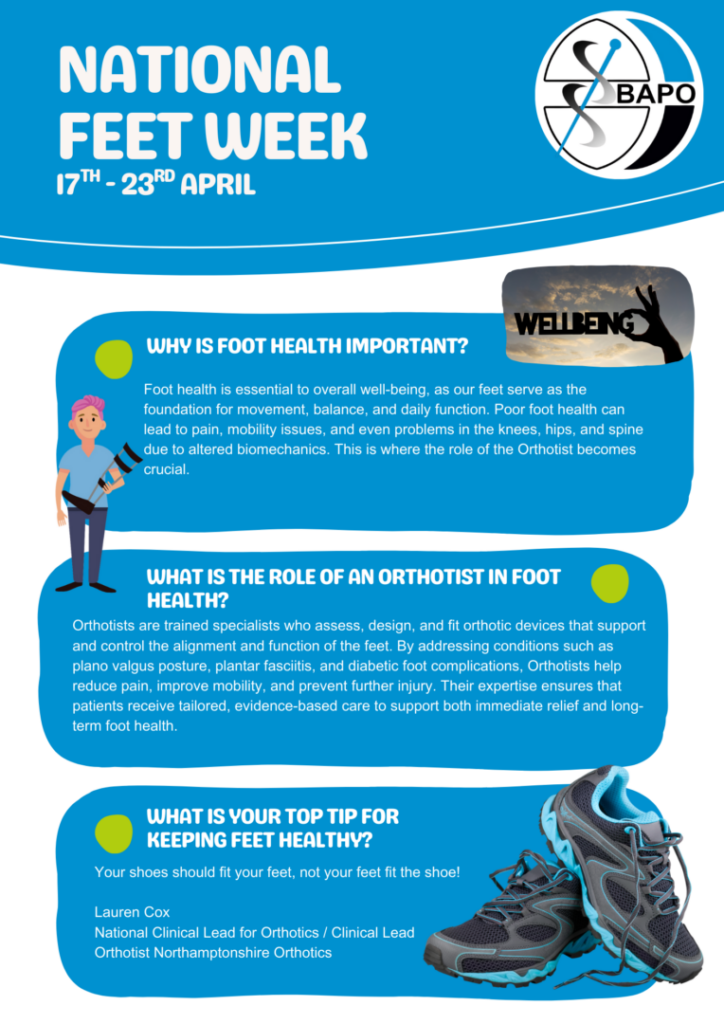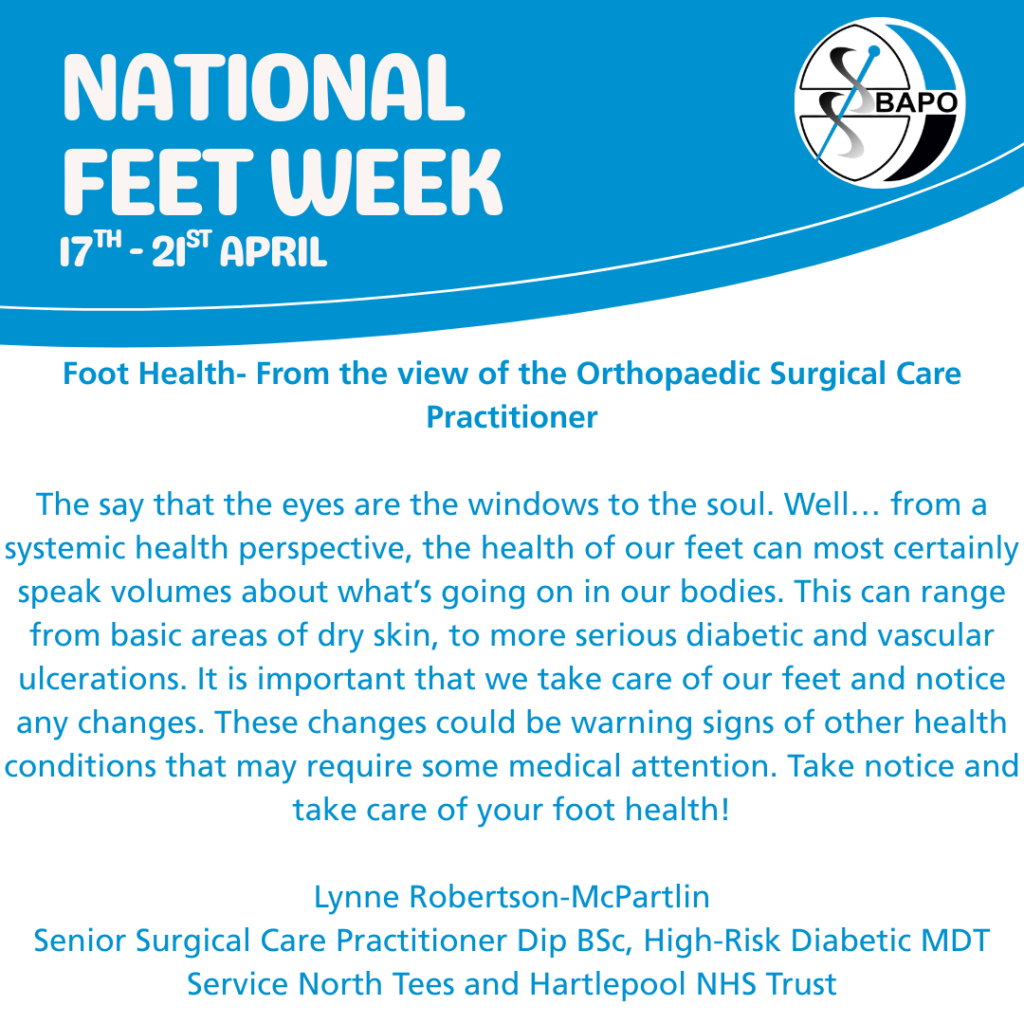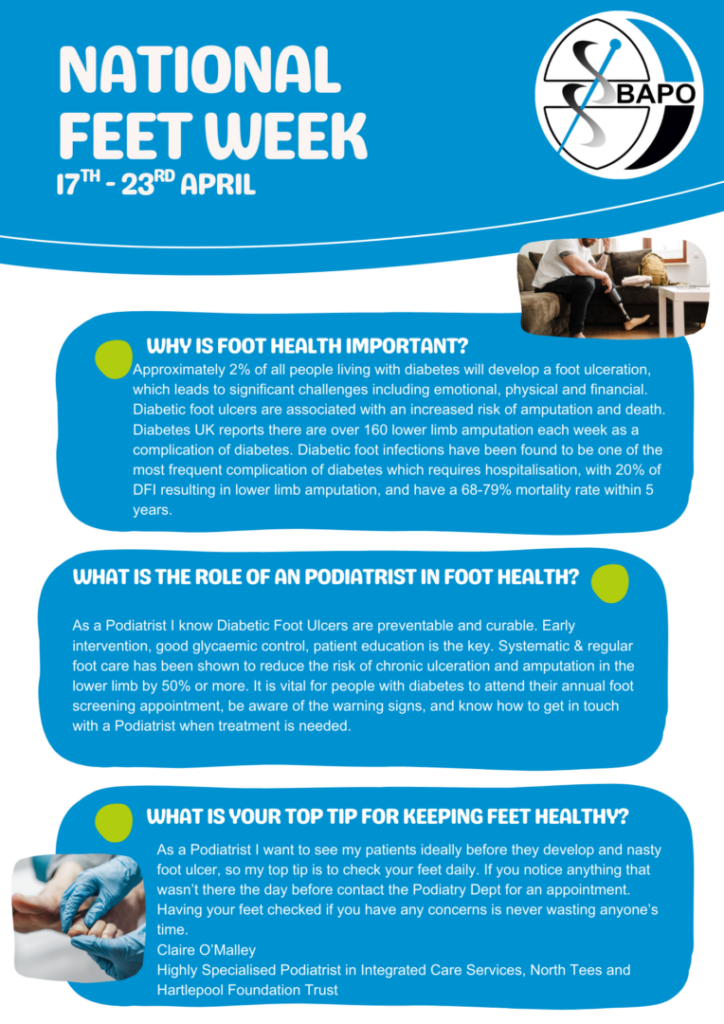Archives for April 2025
National Feet Week 2025
National Feet Week 2025 raises awareness and invites everyone to prioritise foot health. This week we shine a light on how prosthetics and orthotics play a role in good foot health.
Please see the below information collated for National Feet Week from our Education Committee.




Job Advert – Orthotist – Steeper – Leeds Teaching Hospitals
Job Advert – Orthotist – Opcare – London and surrounding areas
Job Advert – Opcare – Orthotist – Great Ormond Street (OCS)
Job Advert – Clinical Orthotist – Peke Waihanga
To tune or not to tune – is that the question?
Details
In two influential studies, a number of UK orthotists have stated they do not ‘tune’ their AFO prescriptions. The definition of tuning is to ‘adjust for optimum performance’, so this finding is puzzling and suggests UK prescriptions may not be optimised. Do these findings reflect the current status of the situation in the UK? What is the evidence for tuning and optimal alignments? Do you align your AFOFCs, and tune or optimise that alignment? If not, what are your barriers to implementation. What is usual practice in the UK, what should it be? This teatime talk will be thought provoking and provocative

Revolutionise Your Health with LimbPower’s Amputee BMI Calculator!
Say goodbye to one-size-fits-all health measurements! LimbPower has created a game-changing Amputee BMI Calculator designed specifically for amputees and individuals with limb differences. This innovative tool factors in limb absence to deliver accurate, personalised BMI results, ensuring a more relevant and meaningful health assessment.
Using it is easy. Simply enter your height, weight, and level of limb loss (left leg, right leg, left arm, or right arm). The calculator instantly adjusts the formula to reflect your unique body composition, giving you a precise BMI score tailored to you.
Why it matters? Understanding your BMI helps you manage weight, optimise prosthetic fit, and take control of your health. Plus, it’s quick and easy—no more inaccurate, generic calculations!
LimbPower has rigorously tested this tool to ensure accuracy and usability. Try it now and take the guesswork out of your health journey! https://www.limbpower.com/exercise/new-amputee-bmi-calculator


BMI word on wood cubes with woman measuring waist hip with a tape at the background. Copy space.
Limb Power – Understanding Phantom Limb Pain: What It Is and How to Cope
Understanding Phantom Limb Pain: What It Is and How to Cope
Phantom limb pain (PLP) is a condition experienced by many amputees, where sensations, often painful, are felt in a limb that is no longer there. For many, this pain is not just physical but deeply psychological, affecting overall quality of life. Understanding what causes phantom limb pain and exploring effective coping mechanisms can provide significant relief and a better pathway to managing this complex condition.
What Is Phantom Limb Pain?
People with phantom limb pain experience acute sensations of pain that appear to come from the limb that has been amputated. It is estimated that between 50 and 80 percent of amputees develop phantom limb pain post-amputation.
The term ‘phantom’ does not mean that the pain is imaginary. Phantom limb pain is a very real phenomenon confirmed through brain imaging scans. Symptoms range from mild flashes of pain, similar to an electric shock, to constant, severe discomfort.
Researchers believe PLP results from a complex interaction between the brain, spinal cord, and nerves, with three main theories explaining its causes:
- The Peripheral Theory: Nerve endings at the stump may form clusters, or neuromas, generating abnormal impulses that the brain interprets as pain.
- The Spinal Theory: Loss of sensory input from the amputated limb causes chemical changes in the central nervous system, triggering pain symptoms.
- The Central Theory: The brain retains a ‘memory’ of the amputated limb and its signals, leading to pain when expected feedback is absent.
Psychologist Keren Fisher explains, “When you lose a limb, the brain doesn’t just stop recognizing it. The neural pathways are still wired to that missing part of the body and continue sending signals as if it’s there.” Stress and trauma often intensify PLP, making it a multifaceted condition requiring a holistic approach.
Impact on Individuals
Phantom limb pain can profoundly affect daily life. Pain and discomfort may disrupt routines, interfere with sleep, and cause frustration or disconnection from one’s body. Social withdrawal, anxiety, and depression are common, as individuals adjust to life without a limb.
Coping Mechanisms and Effective Therapies
While there is no universal cure for phantom limb pain, several therapies and techniques have proven effective:
- Mirror Therapy
Mirror therapy uses a mirror placed in front of the intact limb to simulate movements in the missing limb, tricking the brain into perceiving the limb as functional and alleviating pain. - Cognitive Behavioural Therapy (CBT)
CBT helps amputees reframe negative thought patterns. A study in the Journal of Pain Research found that patients undergoing CBT reported a 30–50% reduction in pain intensity. - Mindfulness and Relaxation Techniques
Deep breathing, meditation, and mindfulness exercises calm the nervous system and reduce stress, which exacerbates PLP. - Medications and Pain Management
Doctors may prescribe medications such as anticonvulsants (e.g., gabapentin), antidepressants (e.g., amitriptyline), or opioids (e.g., codeine, morphine). However, opioids carry risks of dependency and are generally used cautiously. - Non-Invasive Techniques
- Heat or cold applications (e.g., ice packs or creams).
- Massage to improve circulation and muscle stimulation.
- Acupuncture to stimulate specific points and relieve pain.
- Transcutaneous electrical nerve stimulation (TENS) disrupts pain signals and stimulates endorphin release through small electrical impulses delivered to the stump.
- Mental Imagery and Mirror Visual Feedback
Imagining movements like stretching phantom fingers or toes can reduce pain. Similarly, mirror boxes provide visual feedback to the brain, reducing discomfort by simulating the presence of the missing limb. - Advancements in Prosthetics
Prosthetics with sensory feedback mechanisms reconnect the brain to physical sensations, reducing PLP. Kiera Roche praised her microprocessor knee, saying, “It doesn’t just restore mobility; it can reduce phantom pain by giving your brain sensory feedback.”
The Power of Community Support: Stuff That Works Research Community
While individual treatments can help manage phantom limb pain, many amputees find that connecting with others who share similar experiences is equally beneficial. The Stuff That Works community is an invaluable resource for those seeking support, shared experiences, and research-backed insights into managing PLP effectively.
By joining the Stuff That Works Phantom Limb Syndrome Community, individuals can learn from real-world experiences, discover what treatments have worked for others, and contribute their own stories to collective research. The platform enables members to find practical solutions that go beyond medical literature, fostering a sense of belonging and empowerment.
To read about other lived experiences and contribute to the community, visit:
🔗 Phantom Limb Syndrome Community
🔗 Residual Limb Pain Community
The Importance of a Holistic Approach
For many amputees, managing phantom limb pain requires a combination of therapies tailored to individual needs. Kiera Roche emphasised, “Dealing with phantom limb pain isn’t just about fixing the physical sensations—it’s about treating the whole person. Healing happens when you focus on your body, mind, and spirit together.”
Phantom limb pain is a challenging condition, but with the right strategies and a strong support network, it can be managed effectively. By understanding the science behind PLP, exploring proven coping mechanisms, and engaging with supportive communities like Stuff That Works, amputees can regain a sense of control and lead fulfilling lives.

Job Advert – Clinical Link Tutor in Enhanced Practice (Prosthetics and Orthotics)
0.4 FTE 1 year secondment opportunity!

Opportunity overview
We are looking for current NHS clinical colleagues to join our Enhanced Practice (EP) team in the Directorate of Allied and Public Health at the University of Salford. We have 4 positions with one post in each of the following professions: Podiatry, Diagnostic Radiography, Physiotherapist, Prosthetics and Orthotics.
This role will focus on leading the Prosthetics and Orthotics professional pathway within an NHSE funded, one year project which will enable the upskilling, development, delivery and sustainability of the Enhanced Clinical Practitioner apprenticeship in England.
The post holder will utilise their clinical expertise, experience and networks to support the development of the registered Prosthetics and Orthotics workforce. They will have experience of supporting learning and workforce development in the practice / clinical environment. The post holder will have the ability to develop and utilise professional networks with support from the Project Lead to drive enhanced practice within Prosthetics and Orthotics, supporting employers in developing pathways for enhanced clinical practice and career development.
Key responsibilities
- Work with the EP team to collaborate with employers, health professionals and industry partners to scope the needs for ECP development and delivery within Prosthetics and Orthotics
- Design and deliver a range of teaching and learning approaches for apprentices and non-apprentices including mentorship and coaching.
- Link with employers to develop and co-ordinate Prosthetics and Orthotics ECP pathways which facilitate recruitment, sustainability and excellent student experience.
- Supervise ECP student projects, including work-based learning.
- Extend, transform and apply own knowledge to learning, research and external activities which promote ECP readiness and delivery.
- Promote equality and diversity within ECP to sustain inclusive and supportive practices in accordance with university policy.
How to apply
To apply please submit your CV and 1 side of A4 (500 words) on how your knowledge, skills and experience meet the key responsibilities of the role.
Closing date for applications is 12 noon on Thursday 17th April. Please send applications to h.slater3@salford.ac.uk.
Interviews are scheduled to take place on Thursday 24th April.
A bit about our School
With over 8,000 students we are the largest School at the University, with colleagues and students from all over the world. We are a forward-thinking, dynamic school with a commitment to lifelong learning and real-world impact.
We offer programmes across a range of subject areas including counselling, nursing and midwifery, allied and public health, psychology, sociology, social work and social policy, policing and criminology, and sport.
Through our interdisciplinary research network and three research centres, we focus on improving health, social and individual outcomes.
We are part of the global healthcare community and collaboration is at the heart of what we do, working with a wide range of industry partners locally, regionally and globally.
We value diversity – in backgrounds and in experiences. Our difference makes us stronger, and together we share a passion for improving students’ lives.
We have a commitment to be Net Zero by 2038 and embed sustainability in all aspects of university life.
By joining us, you will become part of a wide network of professionals, sharing knowledge and expertise. Like us, you will be passionate and committed and will be part of our ambitious journey, to shape the health professionals, community and social leaders of the future.
Further information on Enhanced Practice can be found here https://www.hee.nhs.uk/our-work/enhanced-clinical-practice-apprenticeships/ahp-enhanced-practice-0
Details of our ECP apprenticeship programme and PGCert Enhanced Practice scan be found at PgCert Enhanced Clinical Practitioner (Enhanced Clinical Practitioner Apprenticeship) | University of Salford
Further detail can be found in the below job description and person specification: